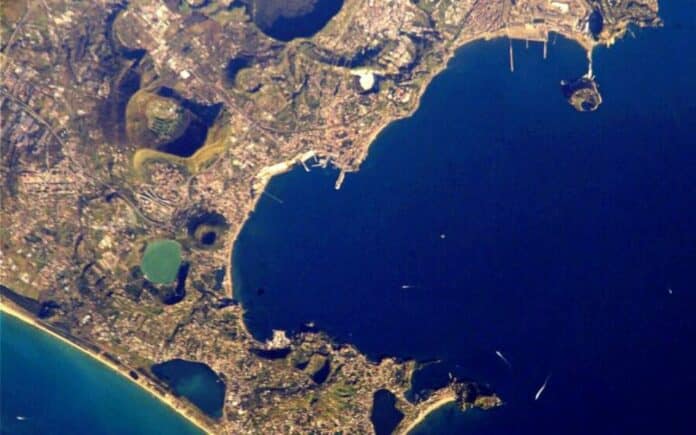There are enormous calderas with a width of more than 5 km at one in ten historically active volcanoes. These volcanoes frequently experience several periods of instability over many years before erupting, depending on their forerunners’ additive impacts. As a result of the potential for structural changes in the crust, these episodes have the potential to sow discord and invalidate traditional eruption predictions.
Researchers from the National Research Institute for Geophysics and Volcanology (INGV) in Italy and the University of California, Los Angeles (UCL) have found that the Campi Flegrei volcano in southern Italy is deteriorating and more prone to erupting.
Volcanoes that reawaken after a long period of dormancy shatter the crust before magma can erupt. Repeatable seismicity fluctuations with ground movement precede rupture, tracing applied stress from local earthquakes. Since 2004, a rupturing sequence has developed at Italy’s Campi Flegrei caldera.
The volcano last erupted in 1538 and has been unrest-free for more than 70 years, with two-year increases in the 1950s, 1970s, and 1980s and a slower period in the past ten years. During these times, tens of thousands of minor earthquakes have occurred, and the coastal town of Pozzuoli has risen by almost 4 meters.
The study, published in Nature Communications Earth & Environment, used a fracturing volcano model created at UCL to evaluate earthquakes and ground uplift patterns and determined that portions of the volcano had been stretched nearly to breaking point.
Lead author Professor Christopher Kilburn (UCL Earth Sciences) said, “Our new study confirms that Campi Flegrei is moving closer to rupture. However, this does not guarantee an eruption. The breach may have opened a break in the crust, but magma must still be moving up in the appropriate place for an eruption.
The study is the first of its sort to forecast a rupture at an active volcano, marking a significant step forward in their goal of improving eruption forecasts worldwide.
They used the model for the first time in 2017. Campi Flegrei has behaved exactly as they predicted, with an increasing number of small earthquakes indicating pressure from below.
They will now have to revise our procedures for estimating the likelihood of new routes for magma or gas reaching the surface.
Dr. Nicola Alessandro Pino from the Vesuvius Observatory, representing the INGV in Naples, said, “Our results show that parts of the volcano are weakening. This means it might break even though the stresses pulling it apart are smaller than during the last crisis 40 years ago.”
Campi Flegrei is the nearest active volcano to London, with a mild depression 12-14 km across that explains why 360,000 people live on its roof.
The ground beneath Pozzuoli has been rising at around 10 cm (4 in) per year for the past decade. Persistent minor earthquakes have also been recorded for the first time since the mid-1980s. The flow of fluids around 3 km (2 miles) beneath the surface, some of which may be molten rock, magma, or natural volcanic gas, has created the disruption.
The most recent period of disturbance appears to be driven by magmatic gas seeping into cracks in the rock and filling the three km-thick crust like a sponge.
Earthquakes occur when faults (cracks) slip as the crust stretches. The pattern of earthquakes since 2020 indicates that the rock is responding inelastically, breaking rather than bending.
Dr. Stefania Danesi from INGV Bologna said, “We cannot see what is happening underground. Instead, we have to decipher the clues the volcano gives us, such as earthquakes and uplift of the ground.”
The effect of the disturbance since the 1950s is cumulative, which means that an eventual eruption could be preceded by relatively minor indications like slower ground uplift and fewer earthquakes. The current tensile strength of Campi Flegrei is believed to be roughly one-third of what it was in 1984.
The team emphasized that an eruption was not inevitable. Dr. Stefano Carlino from the Vesuvius Observatory explained, “It’s the same for all volcanoes that have been quiet for generations. Campi Flegrei may settle into a new routine of gently rising and subsiding, as seen at similar volcanoes worldwide, or return to rest. We can’t yet say for sure what will happen. The important point is to be prepared for all outcomes.”
Professor Kilburn and colleagues will now apply the UCL volcano fracture model to other volcanoes that have reawakened after a lengthy period of dormancy to develop more reliable criteria for determining if an eruption is likely.
Currently, eruptions are predicted using statistical data specific to each volcano rather than depending on fundamental principles applicable to several volcanoes.
This is the first study to forecast eruption at an active volcano. It is a significant advancement in our goal of improving global eruption forecasting.
Journal Reference:
- Kilburn, C.R.J., Carlino, et al. Potential for rupture before the eruption at Campi Flegrei caldera, Southern Italy. Communication Earth & Environment. DOI: 10.1038/s43247-023-00842-1
